AMD Kaveri Review: A8-7600 and A10-7850K Tested
by Ian Cutress & Rahul Garg on January 14, 2014 8:00 AM ESTCPU Performance
I often make a big song and dance about real world benchmarks being the main focus of a reviewer. Synthetics often stress parts of the CPU and distort advantages that a CPU might have and thus not affect you or me in the same manner when using the machine normally. For 2014 I have updated my usual benchmarking set, to include more video encoding and an image converter that takes 2D images and performs algorithms to convert the data into a 3D model. Some 2013 benchmarks are still here, showing what can be done, and to bring parity to previous CPU reviews, some synthetics are also included.
Agisoft Photoscan v1.0 - link
Our new main benchmark to AnandTech is provided by Agisoft. Their Photoscan software creates 3D models from 2D images, a process which is very computationally expensive. The algorithm is split into four distinct phases, and different phases of the model reconstruction require either fast memory, fast IPC, more cores, or even OpenCL compute devices to hand. Agisoft supplied us with a special version of the software to script the process, where we take 50 images of a stately home and convert it into a medium quality model. This benchmark typically takes around 15-20 minutes on a high end PC on the CPU alone, with GPUs reducing the time.
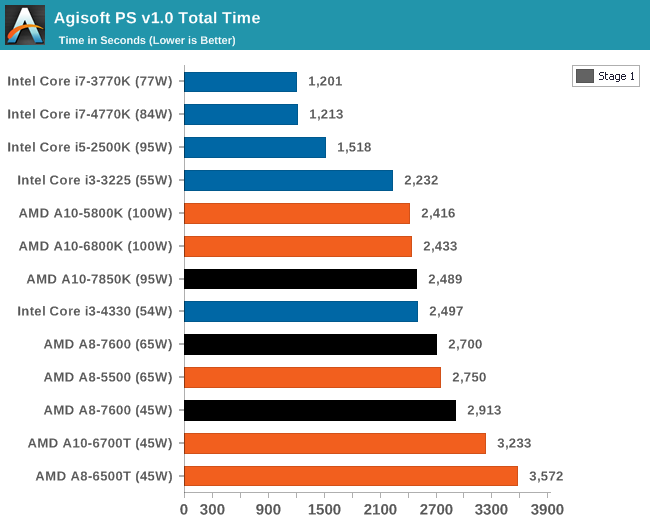
AMD suffers in overall time due to the lack of full-blooded cores and the reliance on single threaded performance in certain parts of the algorithm.
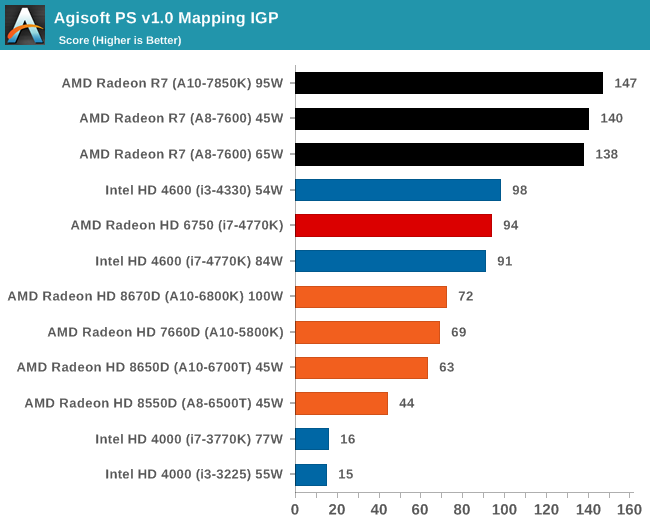
The second stage of the benchmark can be accelerated by the IGP of an APU, and as a result we can see the power of the high end APUs for this work can outshine any CPU we tested today. This is really the promise of HSA, it's just going to take a while to get there for most apps.
3D Particle Movement - link
3DPM is a self-penned benchmark, taking basic 3D movement algorithms used in Brownian Motion simulations and testing them for speed. High floating point performance, MHz and IPC wins in the single thread version, whereas the multithread version has to handle the threads and loves more cores.
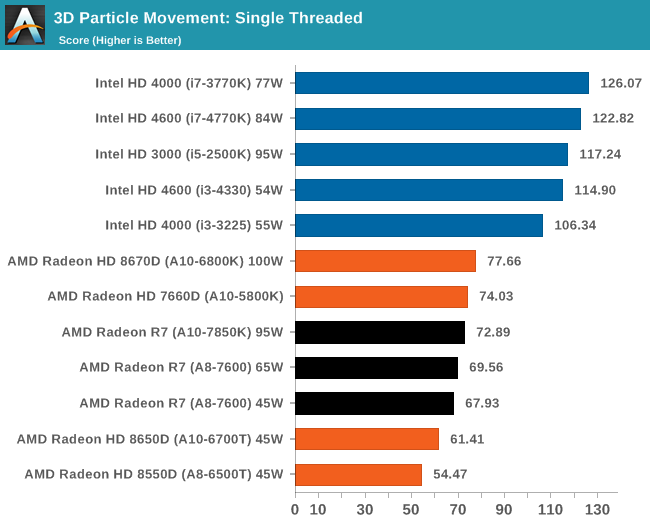
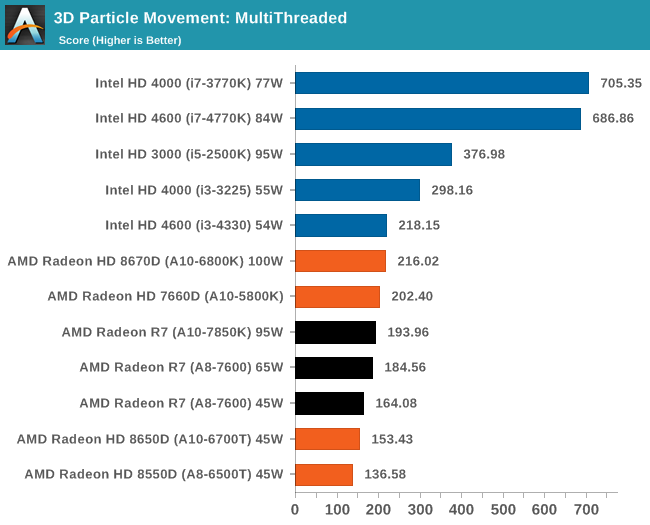
AMD is still suffering a lack of FP performance in our 3DPM benchmark.
WinRAR 5.01 - link
Our WinRAR test from 2013 is updated to the latest version of WinRAR at the start of 2014. We compress a set of 2867 files across 320 folders totaling 1.52 GB in size – 95% of these files are small typical website files, and the rest (90% of the size) are small 30 second 720p videos.
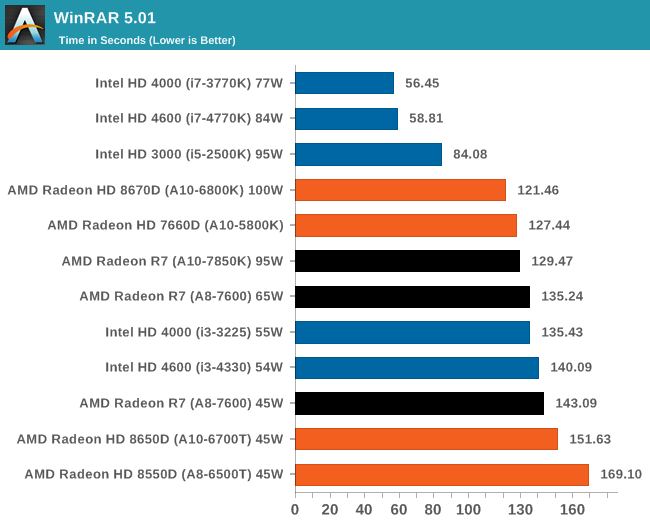
WinRAR loves IPC from the high end Intel chips, but even against the older i5-2500K there is still a deficit. The 45W Kaveri APU however is within fighting distance of its main rival.
FastStone Image Viewer 4.9 - link
Similarly to WinRAR, the FastStone test us updated for 2014 to the latest version. FastStone is the program I use to perform quick or bulk actions on images, such as resizing, adjusting for color and cropping. In our test we take a series of 170 images in various sizes and formats and convert them all into 640x480 .gif files, maintaining the aspect ratio. FastStone does not use multithreading for this test, and thus single threaded performance is often the winner.
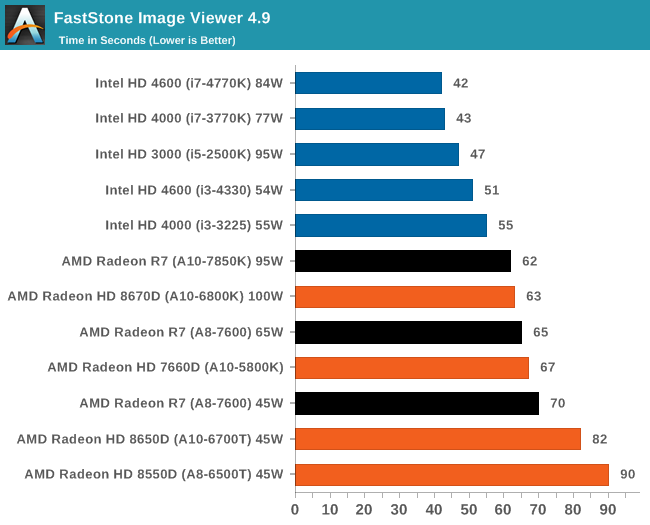
FastStone wants single threaded performance, so Intel wins here again.










380 Comments
View All Comments
SofS - Wednesday, January 22, 2014 - link
Following your links and looking around I found:http://www.tomshardware.com/reviews/core-memory-sc...
It links to previous similar articles concerning the Phenon II and the i7 of the time (975). Seems that indeed the C2Q does not benefit much from memory improvements compared to the other two, but there is a difference. This and all of those three cases are relevant since all three models were very popular. Also, I remember choosing the on time smaller modules for my first kit whit this particular system since they were the only reasonable DDR3 modules at 1600 within reach, albeit I never managed to stabilize it at CL6. On the other hand the latter I upgraded with got CL6 from XMP since the beginning while being larger. Given that memory is very cheap compared to the whole system plus the cost of repurchasing non portable software then this (maybe also a new GPU) might just be the final push needed to wait for the next generation native DDR4 systems for many.
fokka - Tuesday, January 14, 2014 - link
i understand your sentiment, but then again, about every modern mainstream cpu should destroy a c2d and even quad in raw performance. and you even get relatively capable integrated graphics included in the package, so about everyone even moderately interested in computing performance and efficiency "should bite the bullet" if he's got a couple hundred bucks on the side.just4U - Wednesday, January 15, 2014 - link
and that's the problem.. their not. "It's good enough" Numbers are.. just that numbers. We hit a wall in 2008 (or there abouts..) and while performance kept increasing it's been in smaller increments. Over the span of several generations that really can add up but not the way it once did.It used to be you'd get on a old system and it would be like pulling teeth because the differences were very noticeable and in some cases they still are.. but for the most part? Not so much.. not for normal/casual usage. There is a ceiling .. Athlon X2s P4s? No.. you'll notice it.. Quad 8x Core2? hmmm.. How about a socket 1366 cpu or the 1156 stuff? Or the PIIs from AMD. Those people should upgrade? Certainly if their board dies and they can't replace.. but otherwise not so much.
just4U - Wednesday, January 15, 2014 - link
That should have read Quad 8x series Core2s.. anyway these days It seems like we do a lot more change out video, add in ssd, increase ram, rather then build systems from the ground up as systems can stick around longer and still be quite viable. Yes/no?tcube - Thursday, January 16, 2014 - link
Totaly agree. We're led to believe that we need to upgrade every 2 years or so... yet a great many are still using old cpu's even dual cores with new software and os without a care in the world. Because there is no noticeable improvement in cpu usage. Cpu power became irrelevant after C2Q nothing beyond that power is justifiable in normal home or office usage. Certainly certain professional users will want a cheap workstation and will buy into the highend pc market likewise extreme gamers or just for bragging rights. But thinking that for anything from browsing to medium photoshop usage or any moderate videoediting software use will REQUIRE anything past a quadcore like lowend i5's or this kaveri is plain false. You will however notice the lack of a powerful gpu when gaming or doing other gpu intensive tasks... so amd has a clear winner here.I do agree it's not suited for heavy x86 work... but honestly... most software stacks that previously relied heavily on cpu are moving to opencl to get a massive boost from the gpu... photoshop being just one of many... so yeah the powerful gpu on kaveri is a good incentive to buy, the x86 performance is better then richland which is sufficient for me(as i currently do use a richland cpu) so...
Syllabub - Friday, January 17, 2014 - link
I am not going to try and pick a winner but I follow your line of reasoning. I have a system with a e6750 C2D and Nvidia 9600 that still gets the job done just fine. It might be described as a single purpose type of system meaning I ask it to run one or possibly two programs at the same time. What I think is pretty wild is that when I put it together originally I probably sank something close to $250 into the CPU and GPU purchase while today I potentially get similar performance for under $130 or so. The hard part is buying today in a manner that preserves a level of performance equivalent to the old system; always feel the tug to bump up the performance ladder even if I don't really need it.Flunk - Thursday, January 16, 2014 - link
That doesn't really make sense unless you also include equivalently-priced current Intel processors. People may be moving on from Core 2s but they have the opportunity to buy anything on the market right now, not just AMD chips.PPB - Tuesday, January 14, 2014 - link
Adding a $350 CPU plus $50 GPU to a iGP gaming comparison = Anandtech keeping it classy.MrSpadge - Tuesday, January 14, 2014 - link
You do realize they're not recommending this in any way, just showing the full potential of a low-end discrete GPU which wouldn't be bottlenecked by any modern 3+ core CPU?Homeles - Tuesday, January 14, 2014 - link
PPB being an ignorant critic, as usual."For reference we also benchmarked the only mid-range GPU to hand - a HD 6750 while connected to the i7-4770K."